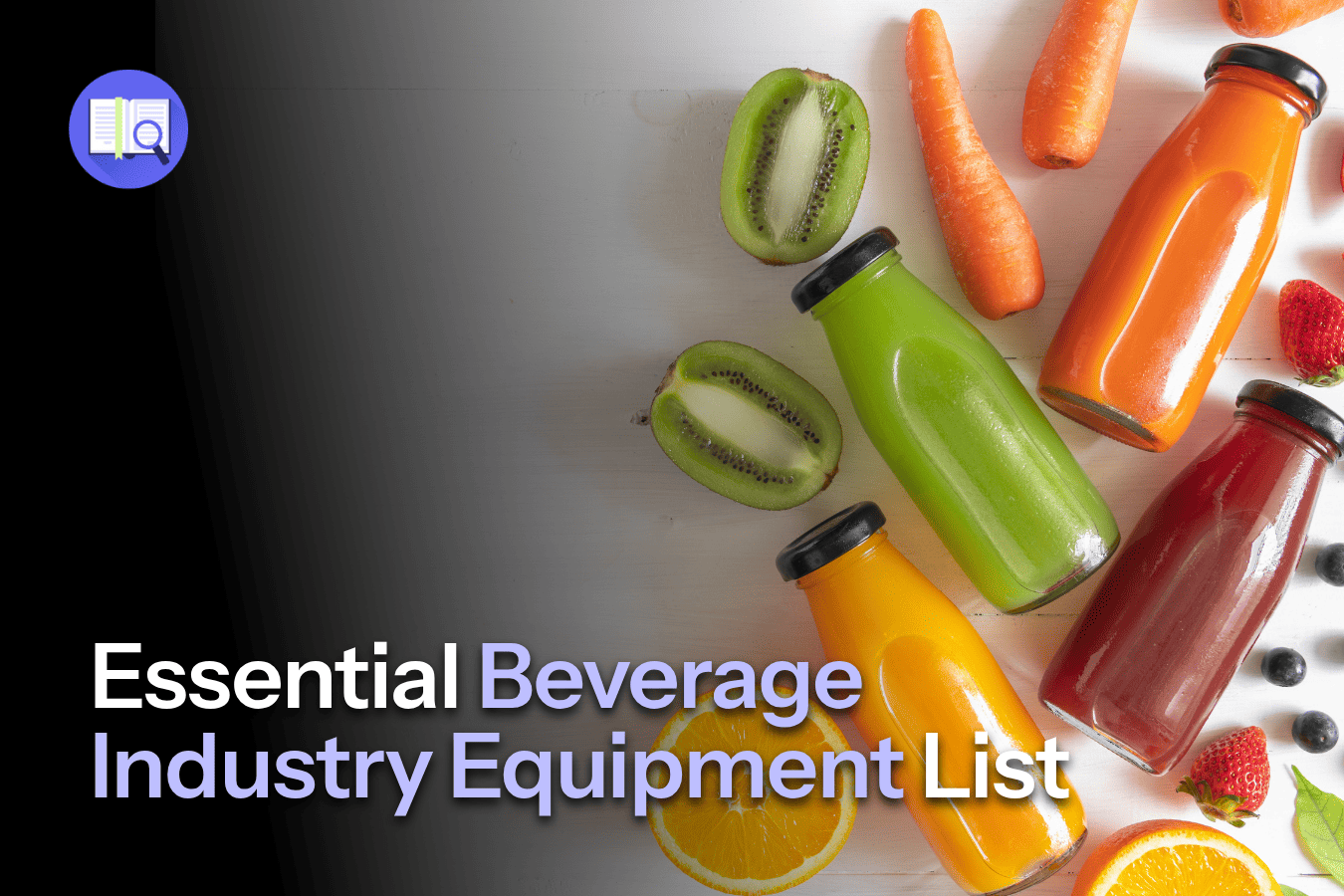
Behind every perfect cup of coffee, every chilled beer, and every fresh smoothie is one simple truth: the beverage industry runs on machines. From espresso brewers and juicers to coolers and draft systems, these tools quietly power daily operations, keeping drinks consistent, safe and served right on time.
The challenge? There’s a lot of equipment out there, and not all of it’s worth the investment. Choosing the right machines – and taking care of them – can mean the difference between a smooth operation and a constant cycle of repairs.
That’s where this guide comes in. In the Essential Beverage Industry Equipment List (2026 Edition), we’ll explore the machines that keep your business running, from coffee systems and cold-press juicers to walk-in coolers and ice dispensers. You’ll learn what each does, why it matters, and how a little preventive maintenance can save you thousands in downtime and repairs.
Let’s get the ball rolling with a quick overview of equipment categories, shall we?

Walk into any café, bar, juice shop or brewery, and you’ll see a lineup of machines humming away – some sparkly and new, others patched together with duct tape (and possibly lots of prayer). From frothers to freezers, every single piece of equipment has its own role in making sure drinks taste great, stay safe, and get served fast.
Now, because the beverage industry is so diverse, there’s no one-size-fits-all setup. A coffee shop doesn’t need beer taps, and a brewery probably doesn’t care much about milk frothers (errrrr .. unless they’re experimenting? Who knows). Still, most beverage operations fall into a few key equipment categories that form the backbone of production and service.
Let’s break it down quickly before we dive into each one in detail later.
This is the heart of most beverage businesses. It includes everything from espresso and drip machines to grinders, frothers, and hot chocolate dispensers. Basically, if it brews, grinds, or steams milk – it lives here. These machines are all about precision and speed, because even a few seconds can mean the difference between a creamy latte and a burnt mess.
Next up are the smoothie blenders, soda dispensers, cold-press juicers and slushie machines. They’re the heroes of any juice bar, fast-food counter or café offering chilled drinks. These systems are designed to handle heavy daily use, so keeping them clean and calibrated isn’t just about taste, it’s about hygiene too.
This is where things get bubbly – literally. Beer taps, draft systems, wine coolers and keg dispensers keep beverages flowing at just the right temperature and pressure. The key here is consistency. The right draft pressure or cooling level makes all the difference between a crisp pour and a flat disappointment.
It might not sound glamorous, but these machines are the unsung heroes of beverage service. Ice makers, hot and cold water dispensers, filtration systems – they all ensure beverages are served safely, at the perfect temperature, and with clean water (which makes up most of your drink anyway).
Soft-serve ice cream machines, milkshake blenders and cup sealers fall into this category. These are often used in dessert cafés, fast-food chains or bubble tea outlets – places where presentation and texture are everything.
This one’s a biggie. Commercial fridges, walk-in coolers and display chillers are crucial for freshness and food safety. Without proper cold storage, even the best ingredients (and equipment) can’t save your drink quality.
In the next sections we’ll dive deep into each one, exploring what the machines do, why they matter and how to keep them in top shape.
Spoiler alert: some of these machines have personalities of their own (especially the ice makers – they love breaking down right before a rush!).
If there’s one smell that can stop people in their tracks, it’s freshly brewed coffee. Ahhh … heaven. But guess what? It ain’t hocus-pocus – your latte doesn’t just appear out of thin air. Behind every perfect cup is a small team of equipment working in sync: the espresso machine pulling precise shots, the grinder slicing beans into even particles, the frother turning milk into foam, and the hot water dispenser keeping everything flowing.
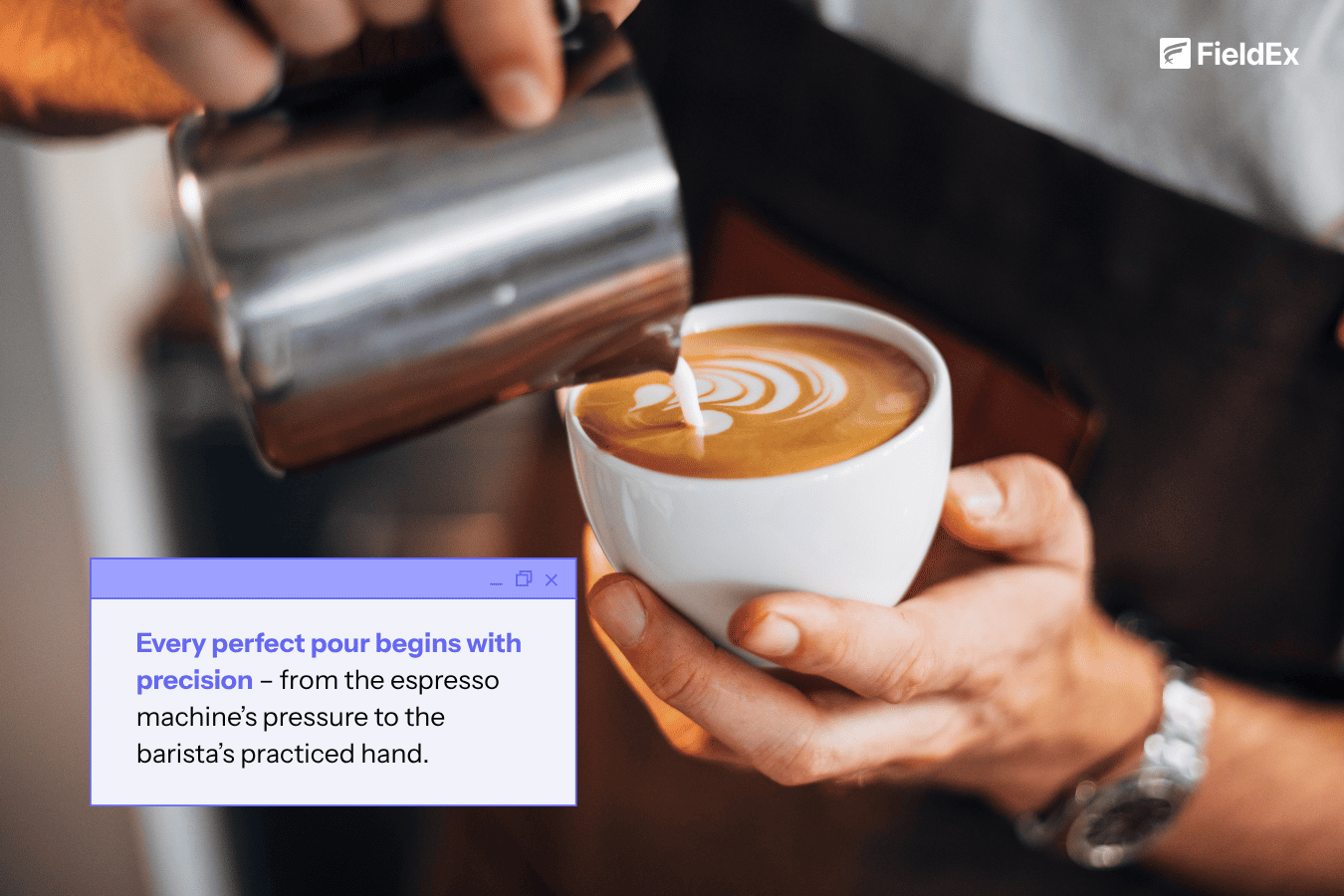
Let’s unpack what makes coffee equipment so special, and why it’s basically the backbone of most beverage businesses.
Each plays a role in making your cup of joe consistent, flavorful and efficient to produce. An espresso machine, for example, works by forcing hot water through tightly packed grounds under intense pressure (usually around 9 bars). If that pressure’s off, your espresso shot could taste weak or bitter.
Sure, being extra chummy with your barista is a nice gesture, but that’s not gonna magically produce the Spanish latte of your dreams. Grind size, water temperature and brewing pressure all affect the flavor profile – and even the tiniest equipment issue can ruin the balance.
Believe it or not, a dull grinder blade can overheat the beans and make your brew taste burnt (yeah, no kidding).
And here’s something that might surprise you: on average, coffee machines run anywhere between 7–10 hours a day in busy cafés; that’s a lot of strain on delicate internal parts such as pumps, gaskets and heating elements. Without regular cleaning and maintenance, things start to fail faster than you’d think.
Beyond taste, equipment health also affects your bottom line. Unplanned downtime can cost thousands per day, and in coffee service, a broken machine means frustrated baristas, long lines, and customers swiftly making a beeline to your competitor next door.
If you run a coffee operation, treat your machines like coworkers. Give them daily check-ins (cleaning), weekly checkups (filter changes, descaling), and monthly performance reviews (calibration). For example:
Simple, right? Still, many operators skip these steps. That’s why preventive maintenance (regular, scheduled servicing) is worth its weight in gold (or coffee beans).
Your coffee machine isn’t just another appliance; it’s a partner in your business. Take care of it, and it’ll take care of you – one perfect pour at a time.

Juice, soda and smoothie machines keep customers cool, refreshed and coming back for more, especially when the weather turns warm.
Walk into any juice bar, fast-food counter or even a hotel breakfast area, and you’ll see a colorful mix of frozen drink machines, soda dispensers, cold-press juicers and commercial blenders humming away in the background. You probably wouldn’t even give them a second thought, but there’s a lot of engineering going on behind that easy-peasy-lemon-squeezy façade.
The beverage industry moves fast, and customers hate waiting for their drink. So, these machines need to deliver consistency, hygiene and speed – all at once.
For example, cold-press juicers use a slow grinding motion instead of blades, which helps preserve vitamins and reduces heat damage. That’s why your cold-pressed green juice looks brighter and tastes fresher than a blended one.
Meanwhile, soda dispensers rely on a balance of syrup ratio, carbonation and temperature. If the CO₂ tank pressure drops or syrup lines aren’t cleaned regularly, your cola will taste flat or off. (If you’ve ever had a weird-tasting fizzy drink at a fast-food joint, now you know why.)
That’s not all – there’s also a hygiene side to this. Ice and drink dispensers can harbor bacteria if not cleaned often, especially those with shared nozzles or unsealed tanks. Bottom line? Regular sanitation isn’t optional, it’s essential.
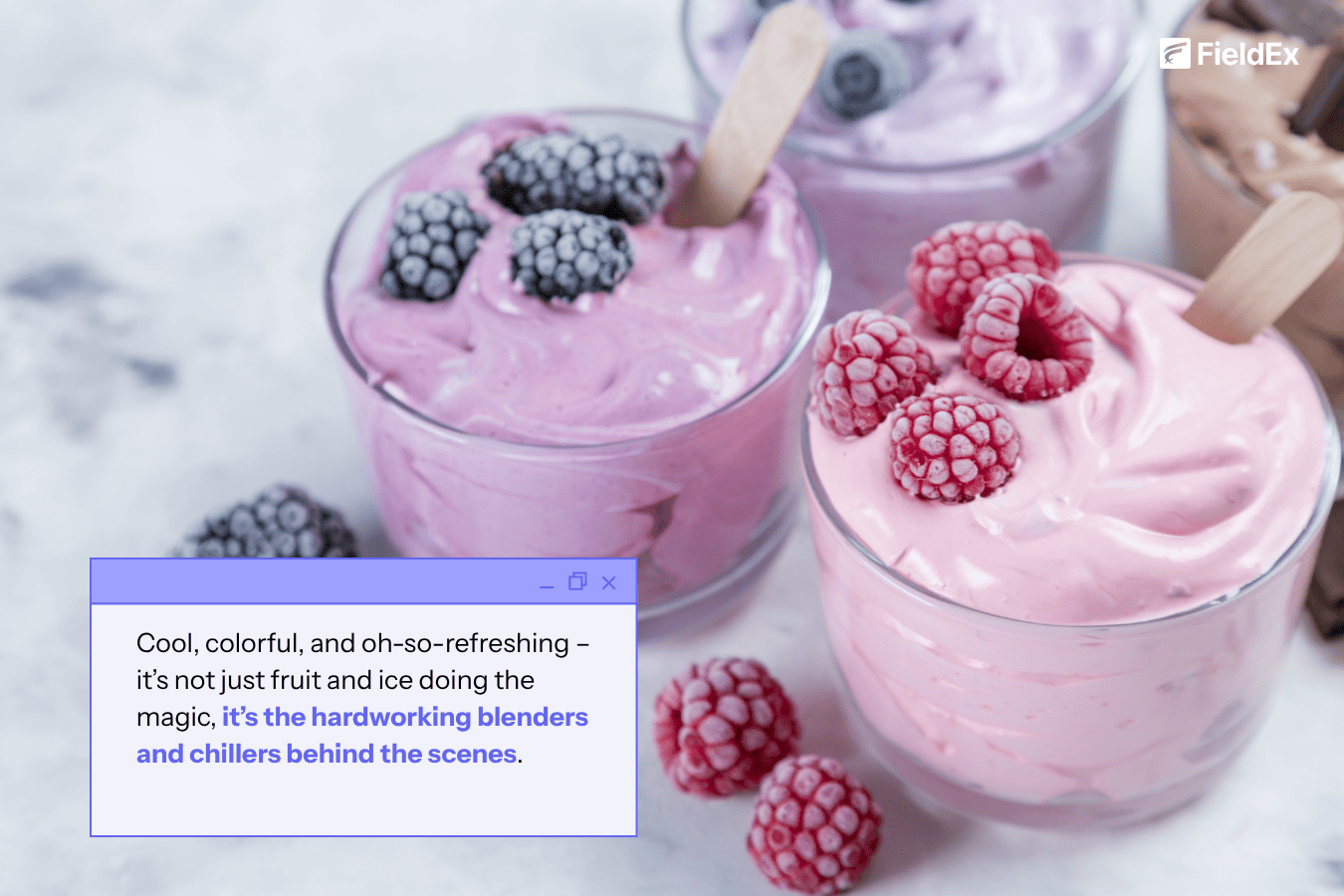
Maintenance here is all about routine and rotation. Remember to:
Why? Cos the sugar content in juices and sodas can quickly turn into sticky residue, attracting mold and pests faster than you think.
And if you’re using a commercial blender:
Dull blades make uneven smoothies and put more stress on the motor, which means it’ll burn out sooner.
You know, they might not say it to your face, but customers – especially regulars – can tell when their favorite drink tastes off. A slightly warm soda or watery slushie might seem minor, but over time, those small inconsistencies chip away at your reputation. So keep your machines tuned, cleaned and calibrated – and your customers will always come back for “the usual”.
You know that satisfying psssht sound at a bar when you’re dying for that crisp pint? Perfection at the end of a long hard day, innit? But did you know that behind every crisp, foamy beer and perfectly chilled glass of wine is a network of machines designed to control temperature, carbonation and flow down to the last drop?
Bars and breweries rely on precision just as much as coffee shops do. Too warm, and you ruin the taste. Too cold, and you lose flavor notes. Too much pressure, and you’ve got foam everywhere. Too little, and the beer pours flat. It’s a delicate balancing act that depends entirely on the quality and health of your equipment.
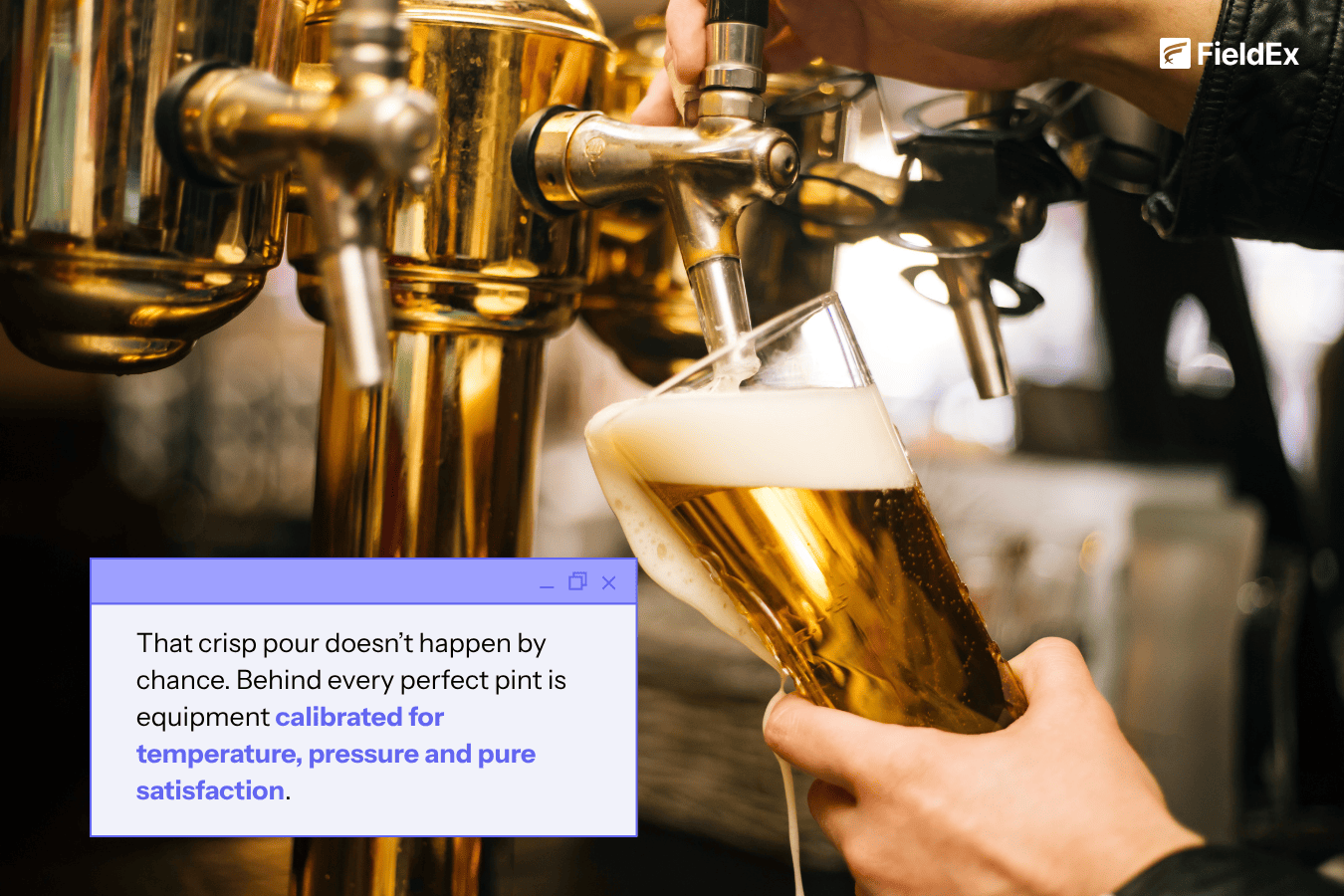
Each piece of equipment has its own set of rules. For instance, a beer draft system depends heavily on balanced CO₂ pressure. Too high, and you’ll get frothy beer that looks great but tastes flat. Too low, and the pour’s sluggish and stale.
The brewing and bar industry is as much about experience as it is about flavor. A warm beer or a dripping tap line isn’t just inconvenient, it’s bad for business. The Brewers Association notes that the US craft beer market alone generated over $28 billion in retail sales in 2023, which means customers have options. A single bad pour could send them somewhere else.
Beyond flavor, cleanliness is huge.
According to the Draught Quality Manual by Brewers Association, dirty lines are the number one reason for “off” beer taste.
Now, let’s talk about beer stones. (Say what?!) Never heard of it? You’re not alone. Beer stones are mineral deposits that form inside beer lines and tanks over time – kind of like plaque, but for your brewery system. If not removed regularly, they harbor bacteria and affect carbonation.
Cleaning your draft system properly takes time, but it’s worth every minute.
If you’re storing kegs for a while:
When it comes to bar and brewery equipment, consistency is king. The best bars in the world don’t just serve good drinks; they serve the same good drinks every single time. And that’s only possible when the equipment behind the counter runs like clockwork.
If coffee machines get all the glory, then ice makers and water dispensers are the unsung heroes holding everything together. It’s very easy to forget how much these systems matter – until, of course, something goes on the fritz and all hell breaks loose. When your ice maker suddenly quits in the middle of a sizzling afternoon, it instantly becomes THE most important machine in the whole bloody building.
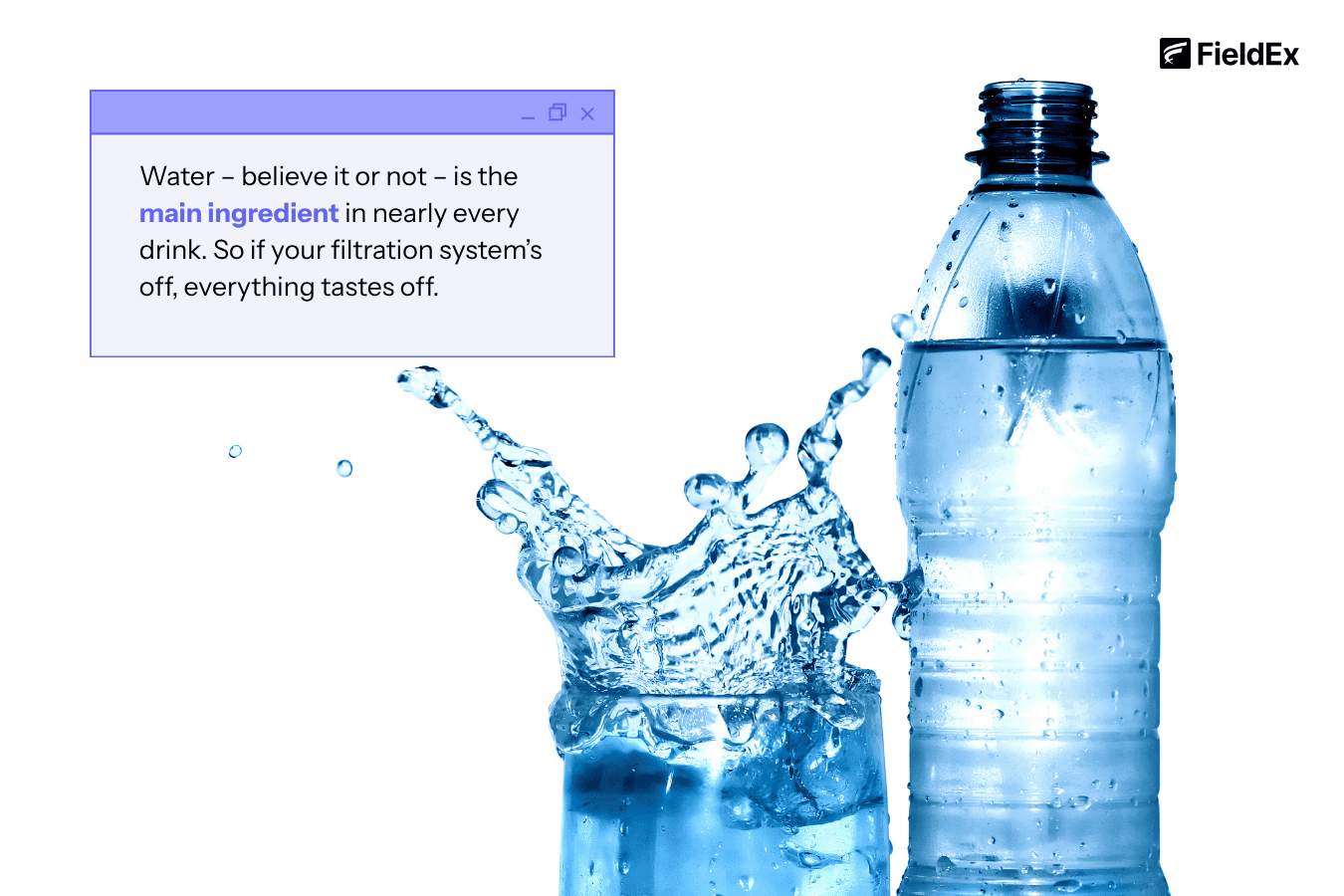
Water – believe it or not – is the main ingredient in nearly every drink. So if your filtration system’s off, everything tastes off.
Here’s a fun fact that might not sound so fun: 70% of beverage machine issues stem from water quality problems, according to Food Service Equipment Journal. Minerals like calcium and magnesium can build up inside pipes and heating elements, forming scale. That scale acts like cholesterol in your machine’s arteries, blocking flow and overheating components.
Poor filtration doesn’t just affect taste; it shortens your equipment’s lifespan too. Hard water leads to corrosion, clogged spray heads and burnt-out heating coils. And those repairs? They’re not cheap.
Then there’s the hygiene factor. Ice machines can harbor bacteria like E. coli and Salmonella if not cleaned properly. Remember, ice is technically a “food product,” so it needs to be handled with the same care as milk or produce.
If your ice tastes funny, the culprit’s usually dirty filters or stale water lines. Here’s what you can do:
And for water dispensers, schedule regular temperature checks. A few degrees off may not seem like much, but lukewarm “cold” water can turn customers off fast.
Ice, water and tea equipment are kinda like the plumbing of your beverage business – invisible when working, catastrophic when not. Stay ahead of breakdowns with preventive care, and you’ll never have to scramble for ice bags during a heatwave again.
C’mon now – who doesn’t get excited at the sight of soft-serve ice cream topped with rich chocolate fudge or luscious strawberry sauce? (I mean, that right there is a priceless moment of sheer, unadulterated joy – bringing out the kid in all of us!)
But did you know those tiny moments of bliss come from machines that work harder than they look? Frozen dessert and specialty drink equipment may not take up as much space as refrigerators or coffee machines, but they’re absolute powerhouses when it comes to customer satisfaction and profitability.
.png)
Each piece of equipment has its quirks. For example:
If you run a dessert or beverage business, these machines are basically your money-makers. A single soft-serve machine can produce 150–200 servings per hour, according to Taylor Freezer, a leading manufacturer of frozen dessert equipment. That’s a lot of cones – and a lot of potential sales.
But these machines are also high-maintenance divas. They’re super sensitive to cleaning routines and temperature fluctuations. Skip a cleaning cycle, and bacteria (such as Listeria monocytogenes) can start forming inside the dispensing system (the CDC actually cites soft-serve machines as potential contamination sources when not sanitized properly).
So, while these machines are great for business, they also demand attention. Preventive maintenance isn’t just about performance, it’s about food safety.
Here’s a quick checklist most pros swear by:
And don’t forget the sealing machines! Replace the film roll before it runs low – low tension leads to half-seals and sticky messes. Always keep a spare roll ready, especially during peak hours.
Frozen dessert and specialty drink machines often sit right in front of customers – which means every breakdown happens in public view. A soft-serve machine that’s “out of order” during a rush isn’t just downtime, it’s lost trust. A little daily TLC keeps the smiles (and sales) flowing smoothly.
If you ask anyone in the beverage industry what their most valuable piece of equipment is, they might say the espresso machine or the draft beer system. But truthfully? It’s probably the refrigerator. Without proper refrigeration, everything else – from your ingredients to your finished products – falls apart.
Cold storage is what keeps your milk from curdling, your juice from spoiling, and your beer tasting crisp. And while most people think of a fridge as just a cooling box, commercial refrigeration is a whole ecosystem of equipment built for precision and reliability.

Each has a unique purpose. A blast chiller, for example, isn’t just a fancy fridge – it drops food or beverages from cooking temperature to safe storage levels (below 5°C) in under 90 minutes, as per FDA guidelines. That’s crucial for food safety.
The beverage industry lives and dies by temperature control. Even a small variance – say, two or three degrees – can alter taste, texture and shelf life. Beer stored too warm loses carbonation and flavor. Milk stored too cold can freeze and separate.
And then there’s energy consumption. Poorly maintained seals, clogged condenser coils, or outdated models can waste hundreds of dollars a month in electricity.
The hygiene side is equally important. Dirty condenser coils or blocked drain lines can lead to mold growth or unpleasant odors – both major red flags during health inspections.
Refrigeration maintenance is less about big repairs and more about small, consistent habits. Here’s what the pros recommend:
For walk-in coolers, avoid stacking boxes directly against walls – it traps heat and strains the compressor.
Refrigeration doesn’t just protect your products, it protects your reputation. A single spoiled batch of juice or milk can lead to wasted inventory, unhappy customers, and even safety violations. Treat your cold storage like the heartbeat of your operation, and it’ll quietly keep everything (and everyone) cool.
From coffee vending machines in office corridors to juice and soda dispensers in retail spaces, vending machines keep the beverage world spinning when human service just isn’t practical.

Vending equipment typically covers:
Each type is designed for speed, consistency and minimal human supervision. A coffee vending machine, for example, measures out precise quantities of grounds, water and milk powder, then delivers a hot cup in under a minute. The beauty? You get hundreds of consistent servings daily without needing a full-time operator.
In high-traffic environments such as hospitals, universities, airports or factory floors, vending machines are often the only source of quick refreshment. Their reliability and hygiene standards directly impact customer satisfaction and trust.
Modern commercial beverage vending machines also integrate IoT sensors that monitor ingredient levels, temperature and service alerts in real time. But with that tech advantage comes maintenance responsibility. Valves clog, heating elements wear out, and neglected cleaning cycles can quickly lead to stale or unsafe drinks.
That’s where smart maintenance systems like FieldEx CMMS step in. With automated service reminders, performance tracking and spare parts management, operators can keep vending fleets running without guesswork – and avoid costly downtime that frustrates both staff and customers.
Treat your vending machines as part of your beverage crew, not just background hardware. Schedule:
If you manage multiple locations, use your CMMS to assign recurring maintenance tasks and track service history. You’ll spot trends before they turn into failure; plus you’ll extend each unit’s life span significantly.
Vending machines may not have personality (not unlike some humans. Hah!), but they do have persistence. They work quietly, deliver consistently, and keep operations flowing 24/7. Keep them clean, calibrated and well-monitored – and they’ll pay you back in uptime, efficiency and a loyal, happy customer base.

Even the best machines have their “bad hair days”. Maybe the ice maker suddenly stops freezing, the espresso machine starts hissing like a hangry cat … or maybe the cooler door refuses to shut all the way.
In the beverage industry, breakdowns don’t just interrupt service; they can ruin ingredients, waste hours, and make customers wonder if there’s “trouble in paradise” – maybe even start planning their next caffeine fix at the new cafe down the block.
The truth is, everyone knows maintenance is crucial, but in the rush of daily business, it often slips through the cracks. Until something breaks, that is.
This one’s all too common. Many operators wait until equipment fails before calling for repairs – because, hey, why fix what’s not broken, right?
The problem is, by the time something is broken, the cost skyrockets. A small leak in a soda dispenser or a worn gasket in a refrigerator might seem minor, but left unattended, it can lead to compressor failure or product spoilage. (By the way, did you know emergency repairs cost nearly 50% more on average than preventive maintenance?)
Between rush hours, deliveries and customer orders, it’s easy to think, “I’ll clean that machine later”. Unfortunately, “later” often becomes “never”. Right?
Missed cleaning cycles are one of the biggest culprits behind machine failure. Residue builds up in soda lines, calcium deposits clog boilers, and bacteria creep into ice bins. Not only does this shorten equipment lifespan, but it also risks contamination.
If you’ve ever asked your team, “When was the last time we serviced this thing?” and been met with silence – you’re not alone.
A lack of record-keeping is a silent killer. Without logs or reminders, even the most diligent teams forget routine checks. Parts don’t get replaced on time, filters stay clogged, and soon enough, that reliable old blender decides to retire early.
When machines get dirty or worn, they have to work harder to perform the same job. That means more electricity, more wear, and higher bills. Refrigerators with dirty coils can use up to 30% more energy; over a year, that’s like paying for an extra appliance you don’t even use.
If you manage several outlets – say, a coffee chain or franchise – keeping track of equipment health across locations can feel impossible. Who’s cleaning what? Which branch reported that leaking cooler? When’s the next service due? Without a centralized system, you’re relying on memory, texts or sticky notes – and that’s a recipe for chaos.
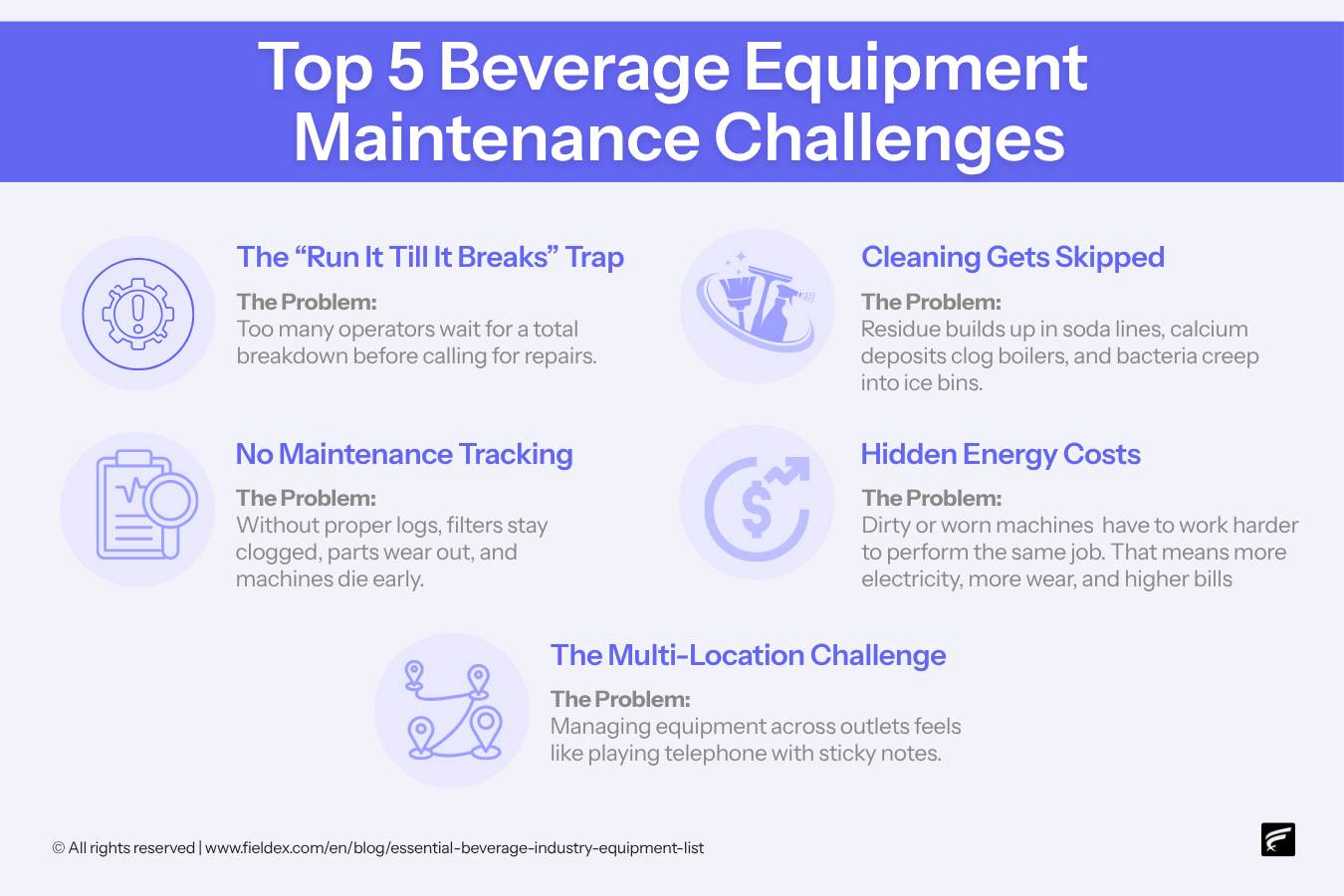
Maintenance might not be glamorous, but it’s what keeps your operation running smoothly. A few minutes a day for cleaning or inspection can save you hours of repair downtime later. The good news? You don’t have to do it all manually anymore – which brings us to something that can make life a whole lot easier. Keep reading!
If you’re an F&B operations manager or supervisor juggling multiple outlets, you’ve already got a to-do list longer than a café receipt on a Monday morning. Staff schedules, supply orders, customer complaints, audits – it never ends, right? So how on earth are you supposed to keep maintenance at the top of your mind too?
That’s exactly where a CMMS comes in. Think of it as your behind-the-scenes maintenance assistant – one that never forgets and never sleeps, and never misses a service date. And FieldEx’s CMMS takes it a step further, automating and simplifying everything from preventive maintenance to inventory tracking, so you can stop firefighting breakdowns and start running smoother operations across every location.
At its core, a CMMS is a platform that helps you plan, track and manage maintenance tasks. Instead of relying on guesswork or sticky notes, you have a system that automatically reminds your team when it’s time to clean the slushie machine, replace a refrigerator filter, or descale the espresso boiler.
FieldEx does all that – and a lot more – in one place. Here’s how it fits into the beverage industry’s day-to-day reality:
Remember that “run it till it breaks” problem? FieldEx fixes that. It lets you set up recurring maintenance schedules based on time, usage hours, or performance data. So your machines get serviced before they start acting up.
Let’s say your coffee machine needs descaling every 200 cycles – FieldEx will not only track that but also send a reminder when it’s due, generate a work order automatically, and log the service once completed. No guesswork, no missed steps.
Ever had to pause service because you ran out of O-rings or filters? With FieldEx, that doesn’t happen. The system tracks inventory levels and alerts you when parts are running low. For beverage businesses juggling multiple sites – maybe a few cafés or juice bars – that’s a huge advantage.
FieldEx also collects data on each asset: maintenance history, repair costs, downtime frequency – everything. Over time, you start seeing patterns. Maybe the same blender keeps breaking every two months. Maybe that one cooler is an energy hog. With this info, you can make smarter decisions, like whether to repair or replace.
It’s like having a digital maintenance diary that never forgets.
No more “Who was supposed to clean the soda lines?” chaos. FieldEx lets teams log work orders, photos and notes from their phones – perfect for staff who bounce between locations. Managers can see what’s done, what’s pending, and what’s overdue at a glance.
FieldEx takes the guesswork out of upkeep, helps prevent breakdowns and keeps your equipment performing at its best so your drinks (and your customers) stay consistent.
Want to see how FieldEx can keep your coffee machines, freezers and soda dispensers running like new? Book a Free Demo today, or Contact Us to know more!
So now that you know all about the different types of machines out there – from espresso makers to chillers and slushie dispensers, let’s talk about something that often gets overlooked: choosing the right equipment for your specific business.
Because here’s the truth: buying beverage machines isn’t like picking out a blender for your kitchen; it’s more like hiring employees. You want the ones who’ll show up every single day, work their butts off, and not cause drama right smack in the middle of your busiest shift.
Okay, start by thinking about your daily operations. Are you running a fast-paced café with lines out the door, or a cozy bar where people linger for hours?
Sounds simple, right? But did you know that mismatched equipment is one of the most common (and costly) mistakes new business owners make?
No matter how shiny a machine looks on the showroom floor, you’ll eventually need to clean it, service it or replace a part. That’s just life in the beverage business. So always check:
Some brands even partner directly with maintenance software systems (like FieldEx) to automate reminders and track service history. That’s a big plus; it keeps you on schedule without needing to remember every filter change or gasket swap.
Price tags can be deceiving. The cheaper option might look great upfront, but high energy use or frequent repairs can make it more expensive over time.
When comparing models, think about:
A good rule of thumb? If the machine makes you money every day, like a coffee brewer or soda dispenser, it’s worth investing in quality.
Measure twice, buy once. Beverage equipment often needs ventilation clearance, drainage access or water hookups. Nothing kills a renovation buzz like realizing your new refrigerator doesn’t fit through the door.
If possible, mock up your workflow before buying. Where will staff stand? How will customers order? Equipment placement affects both efficiency and safety.
Buy for your peak demand, not your average day. If your busiest Saturday rush doubles your weekday sales, make sure your machines can handle that load comfortably.
Remember: the right equipment isn’t the most expensive – it’s the one that fits your business, your staff and your goals like a glove.
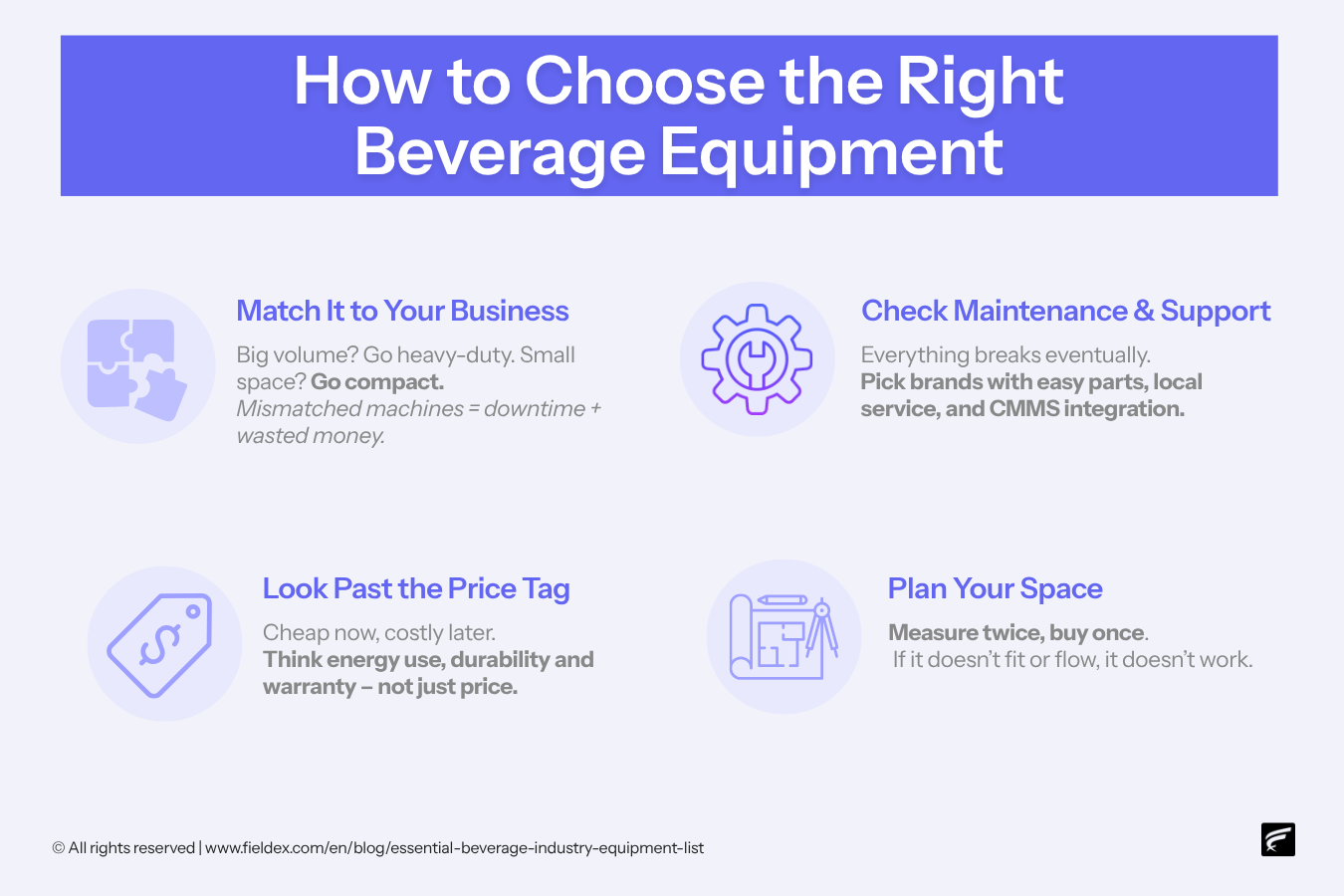
If there’s one thing we’ve learned from looking behind the counter – from coffee machines to coolers, ice makers to mixers – it’s that the beverage business runs on reliability. Every piece of equipment matters, every part plays its role, and when even one machine goes down, it’s like an entire orchestra missing its drummer.
You can have the best beans, the finest syrups, and the friendliest staff, but if your machines aren’t in sync, service suffers. And guess what – customers notice.
The good news? Keeping things running smoothly doesn’t require magic – just a little care, consistency, and the right tools to stay on top of maintenance.
So as you close this guide, take a moment to think about your own setup. Which machine could use a little attention? Which routine could you tighten up? Start there. Consistency and care will always be your most profitable investments.
And if you ever want help streamlining the process, FieldEx is here – quietly doing for your maintenance what your machines do for your drinks: making sure everything flows perfectly.
Curious to see how FieldEx works? Simply book a free demo or get in touch!
Here’s a little gift before you go – because knowing what to do is one thing, but actually doing it consistently is another story. We’ve created a set of FREE downloadable templates, designed to make your beverage equipment maintenance (and day-to-day operations) as smooth and stress-free as possible.
You can grab all of them at once or just pick the ones that fit your setup. They’re simple, and built to keep you organized without eating up your time.
Tip: Print and laminate the daily checklists (like the Coffee Machine Maintenance Checklist and Cleaning Checklist) so staff can tick off tasks with a marker and wipe them clean afterward. It’s a small thing, but it builds habits. And habits build reliability.
Related reads:

.avif)